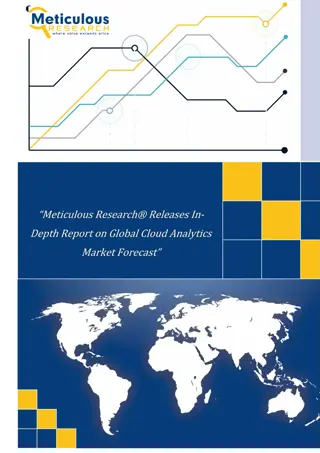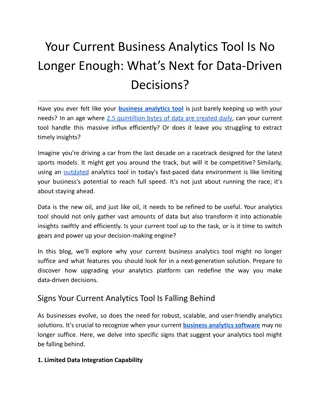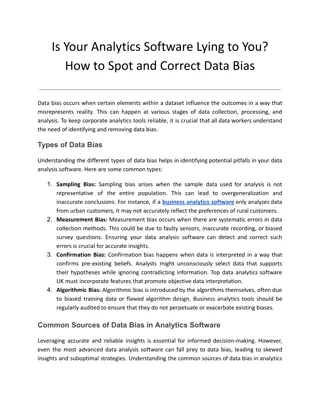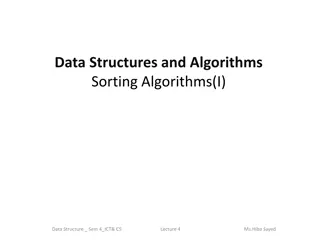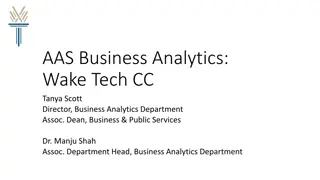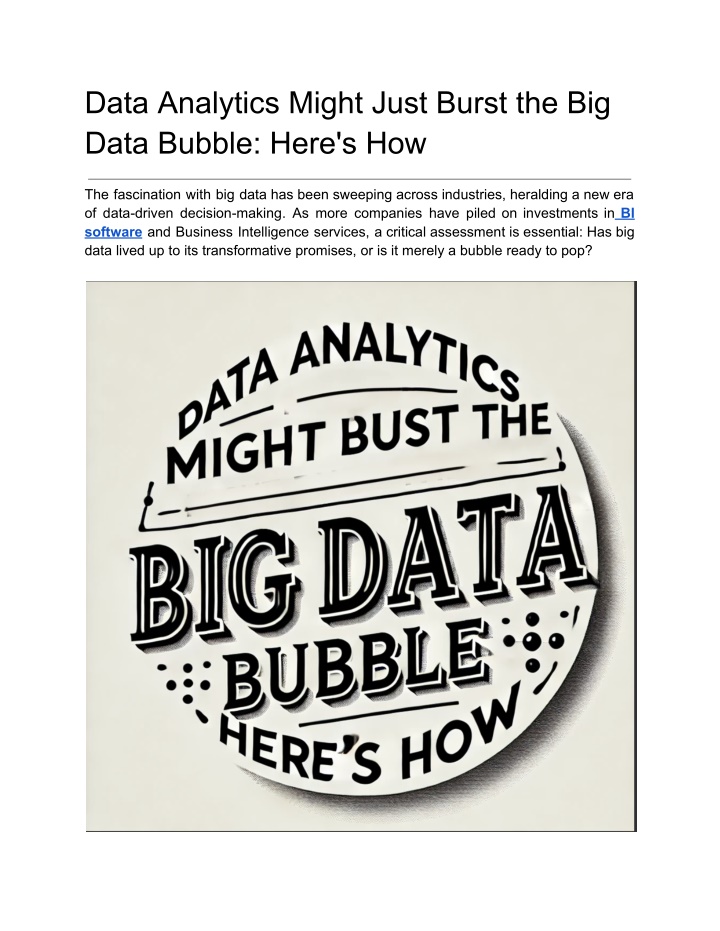
Data Analytics Might Just Burst the Big Data Bubble_ Here's How
Explore the intriguing possibility that data analytics, with its precise focus and actionable insights, might be the pin poised to pop the overinflated big data bubble. This blog delves into how the shift towards targeted analytics is reshaping busin
Download Presentation

Please find below an Image/Link to download the presentation.
The content on the website is provided AS IS for your information and personal use only. It may not be sold, licensed, or shared on other websites without obtaining consent from the author. If you encounter any issues during the download, it is possible that the publisher has removed the file from their server.
You are allowed to download the files provided on this website for personal or commercial use, subject to the condition that they are used lawfully. All files are the property of their respective owners.
The content on the website is provided AS IS for your information and personal use only. It may not be sold, licensed, or shared on other websites without obtaining consent from the author.
E N D
Presentation Transcript
Data Analytics Might Just Burst the Big Data Bubble: Here's How The fascination with big data has been sweeping across industries, heralding a new era of data-driven decision-making. As more companies have piled on investments in BI software and Business Intelligence services, a critical assessment is essential: Has big data lived up to its transformative promises, or is it merely a bubble ready to pop?
Understanding the Big Data Bubble Big data encompasses the vast amounts of information that businesses collect daily. The excitement surrounding its potential has led many to prioritize data collection over analysis, creating an environment where data quantity overshadows quality. This trend suggests a bubble, marked by overinvestment in data accumulation with insufficient focus on actionable insights. The Shift Toward Data Analytics Recognizing the limitations of mere data hoarding, there's a growing emphasis on data analytics. This shift underscores a vital realization: possessing extensive datasets is less crucial than having robust tools and strategies to interpret this data effectively. BI (Business Intelligence) software emerges as a critical player here, equipping businesses with the necessary tools to move from data collection to insightful analysis. The Role of BI Software in Popping the Bubble
BI software is instrumental in addressing the big data bubble's inefficiencies. By incorporating sophisticated data analytics functions, these tools help businesses filter out irrelevant data and focus on the insights that truly matter. They transform the approach from mere data storage to insightful analysis, aligning data strategies with business objectives. Efficiency in Data Processing: BI tools simplify the entire data handling process, from collection to analysis, allowing businesses to leverage their data more effectively. Enhanced Decision-Making: Advanced analytics features within BI software support better decision-making, offering predictive insights and automating routine analysis. Cost Reduction: Focusing on crucial data reduces the costs associated with data storage and processing, making data management more sustainable. The Reality of Data Overload The new oil, according to many, is data, which powers companies and drives decision-making in all industries. Yet, the reality of data overload presents a significant challenge, impacting the efficacy of business operations and the potential benefits of data analytics. Businesses are facing an unprecedented data flood, making the demand for powerful BI software and BI services more pressing than ever. Data overload refers to the scenario where businesses accumulate vast amounts of data faster than they can analyze and utilize it. This glut leads to several issues, such as reduced operational efficiency, increased costs, and missed opportunities for innovation. While data is plentiful, useful ideas from it are scarce, which is the paradox of data overload. This paradox is where the importance of BI (Business Intelligence) software comes into sharp relief. The problem begins when companies invest heavily in data collection without a corresponding investment in data management strategies. The accumulation of unused data not only strains storage systems but also complicates the analysis process, making it harder to find relevant insights. In this context, data analytics emerges not just as a tool but as a necessity for businesses aiming to streamline their operations and make informed decisions. BI software plays a pivotal role in mitigating the effects of data overload by providing businesses with the tools to efficiently process and analyze large datasets. These tools help in filtering out noise and focusing on the data that matters most. Automating mundane data analysis chores is one way BI technologies help since it frees up human
analysts to focus on more difficult problems. They also offer advanced visualization capabilities, making it easier for decision-makers to understand trends, patterns, and outliers at a glance. Moreover, effective Business Intelligence services help organizations develop a coherent data strategy that aligns with their overall business objectives. These services can guide businesses on data governance, ensuring data quality and relevance are maintained. They also assist in implementing BI solutions that are scalable and flexible, accommodating growing data needs without contributing to the overload. As we move forward, the companies that will thrive are those that not only collect data but also use BI (Business Intelligence) software to gain a strategic advantage. The transition from merely having data to intelligently analyzing it involves embracing tools that enhance data literacy across the organization. In order to promote a data-driven culture, it is necessary to educate all employees, from C-suite executives to frontline operational teams, on how to use BI technologies effectively. The Rise of Targeted Data Analytics As the landscape of business technology changes by leaps and bounds, the shift towards targeted data analytics marks a significant evolution from the broader approaches of the past. This focused strategy is not just about collecting data but making sense of it in a way that directly impacts decision-making processes. For businesses, data analytics has become a crucial tool, propelling the need for specialized BI software and comprehensive Business Intelligence services. Targeted data analytics refers to the practice of applying data analysis techniques to specific business problems or opportunities, using precise and relevant data sets to derive actionable insights. This approach contrasts with the earlier trends where companies often found themselves lost in vast oceans of data, trying to leverage every bit of it without a clear direction. The efficiency of BI (Business Intelligence) software in enabling this targeted approach is transforming industries by providing them with the ability to not just react to market conditions, but proactively shape their strategies based on predictive analytics. The rise of targeted data analytics is fueled by the increasing sophistication of BI software that allows companies to more effectively segment their data and apply analytics at various levels of their operations. These tools offer functionalities such as data integration, real-time analytics, and advanced visualization, which are essential for businesses aiming to enhance their decision-making. With these capabilities, companies can pinpoint trends, predict customer behavior, optimize operations, and ultimately increase profitability. operational efficiency and strategic
Moreover, Business Intelligence services play a critical role in helping organizations implement and manage these advanced BI systems. They provide the expertise needed to customize solutions that fit the unique needs of each business, ensuring that data analytics efforts are aligned with strategic goals. These services also assist in data governance and quality assurance, which are vital for maintaining the accuracy and relevance of the data being analyzed. The impact of targeted data analytics is evident across various sectors. In retail, for example, businesses use data analytics to understand consumer buying patterns and tailor their marketing strategies accordingly. In healthcare, analytics enable providers to offer personalized treatments and predict patient outcomes more effectively. Financial services firms leverage analytics to assess risk and make investment decisions that align with their clients' profiles and market conditions. Looking ahead, the future of BI (Business Intelligence) software and services seems intertwined with the advancement of targeted data analytics. As artificial intelligence and machine learning technologies continue to evolve, they will further enhance the capabilities of BI tools, making data analytics even more precise and impactful. This progression promises not only to sustain the growth of individual businesses but also to drive innovation across industries. Data Analytics Techniques That Are Making a Difference The businesses operate and make decisions. With the integration of BI software and business intelligence services, companies are not just managing large datasets but are transforming this data into actionable insights that drive strategic outcomes. Let's delve into specific data analytics techniques that are making a marked difference in the business world, shaping the functionality and impact of BI (Business Intelligence) software. application of advanced data analytics techniques is revolutionizing how
Predictive Analytics Predictive analytics stands out as a cornerstone technique in data analytics, utilizing historical data, statistical algorithms, and machine learning techniques to forecast future events. This approach has become invaluable for industries ranging from finance to retail, enabling companies to anticipate market trends, consumer behavior, and potential risks. BI software that incorporates predictive models helps businesses optimize their operations, improve customer satisfaction, and increase revenue by making proactive decisions based on predictive insights. Machine Learning Machine learning (ML) is another transformative technique under the broad umbrella of data analytics. ML algorithms improve over time, learning from new data inputs without being explicitly programmed. In BI software, ML models are used to automate complex data analyses and adapt to new data dynamically. This capability is crucial for businesses that operate in rapidly changing environments, as it allows for the continuous improvement of operational efficiencies and innovation in product or service offerings. Data Mining Data mining involves exploring large datasets to discover patterns and establish relationships to solve problems through data analysis. Techniques such as clustering,
classification, regression, and association rules are extensively used within BI Business Intelligence software to extract meaningful information from data that can inform strategy and decision-making. These insights are particularly useful in marketing, risk management, and customer relationship management, where understanding deep patterns and trends can significantly impact business outcomes. Real-Time Analytics In an era where speed can equate to competitive advantage, real-time analytics is a crucial technique. This approach uses technology to analyze data as soon as it is available, so decision-makers can act immediately on insights. This instant analysis is supported by BI software designed to handle continuous data streams, allowing businesses to react to market changes swiftly and make decisions based on the latest information. Sectors such as e-commerce, financial services, and online media find real-time analytics especially beneficial, as it enables them to enhance customer experiences and manage operations dynamically. Text Analytics and Natural Language Processing (NLP) Text analytics, supported by NLP, enables the analysis of textual data sources, including customer reviews, feedback, social media conversations, and emails. Business Intelligence services utilize NLP to derive qualitative insights and sentiment from textual data, helping businesses understand customer emotions and preferences. This technique is integrated into BI software to refine customer service strategies, develop targeted marketing campaigns, and manage brand reputation effectively. Geospatial Analytics Geospatial analytics harnesses geographic data to create a geographical model of analysis. This technique is embedded in BI software, providing businesses with insights based on location data. Such insights are crucial for industries like logistics, real estate, and retail, where location plays a key role in operational and strategic decisions. Preparing for a Post-Big Data World As we navigate through the era of big data, the emphasis on sheer data volume is gradually giving way to a more nuanced approach focused on data quality and actionable insights. This shift signals the onset of a post-big data world, where the ability to harness precise and meaningful insights from data analytics becomes the cornerstone of business strategy. For organizations looking to thrive in this evolving landscape, the integration of BI software and Business Intelligence services is essential. This comprehensive analysis explores how businesses can prepare for this transition,
emphasizing the role of BI (Business Intelligence) software in navigating the complexities of modern data environments. Strategic Focus on Data Quality Over Quantity In a post-big data world, the mantra "more is better" is no longer applicable. Instead, the focus shifts towards "better is more," where the quality of data takes precedence over its quantity. Businesses need to adopt data analytics methodologies that prioritize data integrity, relevance, and accuracy. BI software plays a pivotal role in this context by providing tools that enhance data cleansing, integration, and management. These tools ensure that data used for decision-making is not only accurate but also relevant to the specific business questions at hand. Leveraging Advanced Analytics Techniques As the data landscape evolves, so too must the analytics techniques used to decipher it. Advanced analytics capabilities, such as machine learning, predictive analytics, and natural language processing, become vital in extracting valuable insights from smaller, more relevant datasets. BI Business Intelligence software that incorporates these advanced techniques allows businesses to move beyond traditional descriptive analytics and into the realm of predictive and prescriptive analytics. This shift not only enhances decision-making but also provides a competitive edge by forecasting future trends and behaviors. Enhancing Data Governance In a post-big data world, robust data governance becomes increasingly critical. Effective governance ensures that data is managed properly throughout its lifecycle, from creation to deletion. This involves implementing policies and procedures that control data access, quality, and compliance. Business intelligence services can support these efforts by helping organizations establish and maintain strong governance frameworks. These services ensure that data is not only used effectively but also securely, complying with increasingly stringent regulatory requirements. Cultivating a Data-driven Culture Preparing advancements; it demands a cultural shift within the organization. Cultivating a data-driven culture where every decision and strategy is informed by data analytics is essential. This cultural transformation can be facilitated by BI software that is user-friendly and accessible to all levels of the organization. Training and development programs provided by Business Intelligence services can also equip employees with the for a post-big data world requires more than just technological
necessary decision-making becomes part of the organizational DNA. skills to leverage BI tools effectively, ensuring that data-driven Integration with Emerging Technologies The integration of BI tools with other emerging technologies like the Internet of Things (IoT), blockchain, and augmented reality can further enhance the capabilities of data analytics in a post-big data world. These technologies can provide new sources of data and novel ways to visualize and interact with that data, offering deeper insights and more innovative solutions to complex business problems. Conclusion As we transition into an era where the sheer volume of big data is not the primary driver of business intelligence, the imperative shifts to refining data for enhanced utility and impact through precise analytics. BI software and Business Intelligence services are spearheading this shift, equipped with the necessary tools and insights to adeptly manage the nuances of a nuanced data-centric landscape. Prioritizing data quality, leveraging sophisticated analytics, enforcing data-centric culture, and integrating cutting-edge technologies are essential strategies for businesses to effectively exploit the evolving opportunities. stringent governance, fostering a For enterprises poised to set benchmarks in their sectors, Grow offers state-of-the-art BI (Business Intelligence) software solutions tailored to the demands of a refined data environment. Discover how our pioneering BI tools can transform your strategic approach by turning robust data into actionable intelligence that propels business growth and innovation. Explore the potential of data with Grow: Start your journey with a 14-day free trial of Grow's BI tools and experience firsthand how advanced analytics can enhance your business operations. For more insights, read the latest Grow Reviews 2024 to see how other leading companies are leveraging Grow to drive success. Original Source: https://bit.ly/3X1QZdw






